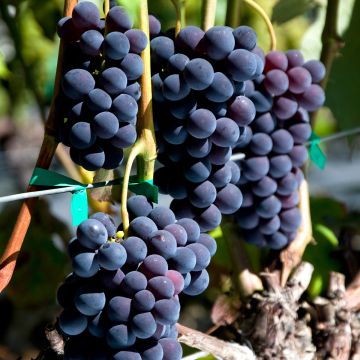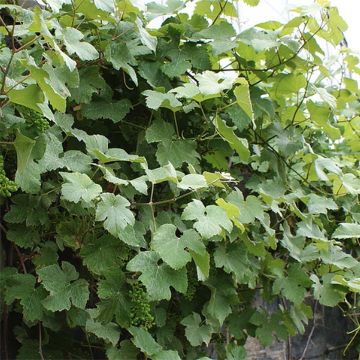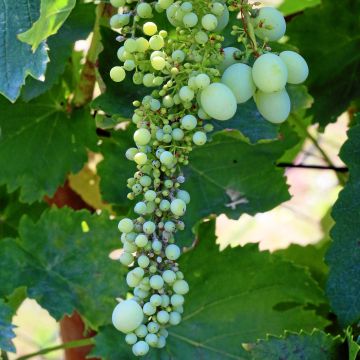

Vitis vinifera Pizzutello Bianco, Cornichon blanc, Pizza Tella Bianco - Grapevine
Vitis vinifera Pizzutello Bianco, Cornichon blanc, Pizza Tella Bianco - Grapevine
Vitis vinifera Pizzutello Bianco, Cornichon blanc
Common Grape Vine, European Grape, Wine Grape
This item cannot be shipped to the selected country
Oversize package delivery charge from €6.90
Delivery to Corse prohibited
More information
Schedule delivery date,
and select date in basket
This plant carries a 6 months recovery warranty
More information
We guarantee the quality of our plants for a full growing cycle, and will replace at our expense any plant that fails to recover under normal climatic and planting conditions.
Oversize package: home delivery by special carrier from €6.90 per order..
Express home delivery from €8.90.
Delivery to Corse prohibited: UE law prohibits the import of this plant from mainland France to Corse as part of the fight against Xylella fastidiosa. Please accept our sincere apologies.
More information
Description
The 'Pizzutello Bianco' Table Grape Vine, known as 'White Gherkin' in France, is an ancient variety that produces beautiful elongated and slightly incurved, crunchy, sweet, fairly neutral, but very pleasant tasting grapes. this late ripening variety is ready for harvest from mid-October to late November and its grapes can be stored until Christmas. The clusters are medium-sized, cylindrical-conical or pyramidal and fairly sparse, weighing 300-400 g. This vine is cultivated in mild climates in regions further south, where it can withstand heat and drought. It is not very resistant to diseases and requires some natural preventive treatments.
The wine grape, in Latin Vitis vinifera, belongs to the Vitaceae family, just like the Virginia Creeper. It has been cultivated for thousands of years in North Africa, the Middle East, the Caucasus, and Europe. Between 1000 and 500 BC, it was introduced by the Romans to Italy, Sicily, Spain, Portugal, and southern France. During this ancient period, wines were diluted with water and flavoured with herbs and spices. The wine we know today was first produced in the Middle Ages. In the 17th century, winemaking shifted towards the production of higher quality wines, but at the end of the 19th century, phylloxera destroyed a large part of the French vineyards, and thus the science of wine, oenology, emerged in the 20th century. This species is cultivated for its clustered fruits called "grapes," which can be consumed fresh as table grapes, fermented into wine, or dried as raisins.
The 'Pizzutello Bianco' grape vine is a very ancient variety originating from Turkey. Long known and today under many synonyms, it is still cultivated in various Mediterranean countries. For example, it can be found in Spain, as it can withstand heat and drought, and has a late ripening of its grapes. It is a plant with long, climbing branches, called canes when they are old and woody, which can reach a spreading of 5 metres or more when trained. The young branches that bear the leaves, fruits, and tendrils that allow the vine to cling to a support are called shoots. Its root system can reach a depth of 5 metres in the soil, providing the vine with good drought resistance. Very aesthetic, the branches are supported by a twisted trunk with bark that peels off in strips with age. With a remarkable longevity, the vine can live for several centuries. Its deciduous foliage consists of alternate large leaves measuring 8 to 16 cm wide with 5 or 7 lobes, toothed along the edges, attached to the branches by a long petiole. They change from tender green at bud burst to medium green during the season, and turn golden yellow, orange, and reddish-purple in autumn, providing a very colourful spectacle. The modest flowering occurs in May-June. Opposite the leaves, it appears in the form of clusters measuring 10 to 12 cm in length, composed of small insignificant, yellowish-green flowers, with 5 protruding stamens. As a self-fertile variety, the hermaphroditic flowers self-pollinate. To form the cluster, the fleshy and globular berries are attached to the stem by small pedicels. The flower buds freeze at temperatures below -2°C, but the late flowering of this variety is not very susceptible to spring frosts. This hardy plant can tolerate temperatures around -20°C, but dislikes summer humidity, which promotes the appearance of spots on the leaves and fruits (powdery mildew, leaf and cluster mildew). This variety is cultivated in well-drained, deep, even poor, dry, and chalky soil.
Table grapes are delicious when eaten raw. They are also ideal for making jams, jellies, fruit juices, clafoutis, cakes, custards, or loaves or for fruit salads with other fruits, or accompanying savoury dishes. Grapes are rich in carbohydrates (glucose and fructose) from 16 to 18 g per 100 g and are a calorie-dense fruit (approx. 80 Cal/100 g). Their content of vitamins B (B2, B6) and C, phenolic antioxidants, fibres, manganese, potassium, calcium and magnesium, with a significant iron contribution, make grapes a healthy choice. They are a healthy, natural, and tasty fruit.
In addition to its fruit-bearing capabilities, the 'Pizzutello Bianco' vine is ornamental when trained on an arbour, pergola, or wall. To have table grapes from August to October, associate it with other earlier varieties, such as: Chasselas Doré, Chasselas Rosé, Roi des Précoces, Centennial Seedless, Perlette, Madeleine Royal, or later varieties: Dattier de Beyrouth, Italia, Muscat d'Alexandrie. Among a wide range of grapevines, it is easy to find the one that best suits one's tastes.
Report an error about the product description
Plant habit
Fruit
Flowering
Foliage
Botanical data
Vitis
vinifera
Pizzutello Bianco, Cornichon blanc
Vitaceae
Common Grape Vine, European Grape, Wine Grape
Cultivar or hybrid
Other Grapevines
Planting and care
Plant the Pizzutello Bianco vine in autumn, in a deep, well-drained, even stony, arid, poor and chalky soil, in a sunlit location, sheltered from strong winds. Incorporate 3 or 4 handfuls of fertiliser for fruit trees and 2 kg of composted manure into the planting soil for each vine. The roots should not come into contact with the manure. After planting, prune above 2 large buds (buds) to obtain two branches. Keep the most vigorous woody climbing stem and tie it to a stake. Training pruning will follow, in a vertical cord, which will be detailed in a lower section.
The vine does not require regular fertiliser application, for good yield, on the contrary. Enrich the soil with potash, crushed horn or iron chelate, only every 2-3 years.
The Pizzutello Bianco vine is sensitive to powdery mildew and oidium. It benefits from preventive treatments such as sprayable sulfur, Bordeaux mixture and nettle manure. The most commonly encountered vine-plant pests are grape cluster moths (Cochylis) and Eudemis (grain caterpillar), which can be treated with insecticidal during vegetation, twice with a fifteen-day interval. There is also powdery mildew (oil spots on the leaf, underside with white fuzz) and grey rot Botrytis (mould in humid weather). For these two fungal diseases, use Bordeaux mixture at the first symptoms. Treat alternately with sulfur against oidium (white-grey felting on the top of the leaves), in good, not too hot weather.
Since the devastation caused by phylloxera at the end of the 19th century, the vine is grafted onto different rootstocks resistant to this disease and adapted to different types of soil. These rootstocks come from American varieties naturally armed against this formidable parasite, itself of American origin.
Planting period
Intended location
Care
This item has not been reviewed yet - be the first to leave a review about it.
Berries
Haven't found what you were looking for?
Hardiness is the lowest winter temperature a plant can endure without suffering serious damage or even dying. However, hardiness is affected by location (a sheltered area, such as a patio), protection (winter cover) and soil type (hardiness is improved by well-drained soil).

Photo Sharing Terms & Conditions
In order to encourage gardeners to interact and share their experiences, Promesse de fleurs offers various media enabling content to be uploaded onto its Site - in particular via the ‘Photo sharing’ module.
The User agrees to refrain from:
- Posting any content that is illegal, prejudicial, insulting, racist, inciteful to hatred, revisionist, contrary to public decency, that infringes on privacy or on the privacy rights of third parties, in particular the publicity rights of persons and goods, intellectual property rights, or the right to privacy.
- Submitting content on behalf of a third party;
- Impersonate the identity of a third party and/or publish any personal information about a third party;
In general, the User undertakes to refrain from any unethical behaviour.
All Content (in particular text, comments, files, images, photos, videos, creative works, etc.), which may be subject to property or intellectual property rights, image or other private rights, shall remain the property of the User, subject to the limited rights granted by the terms of the licence granted by Promesse de fleurs as stated below. Users are at liberty to publish or not to publish such Content on the Site, notably via the ‘Photo Sharing’ facility, and accept that this Content shall be made public and freely accessible, notably on the Internet.
Users further acknowledge, undertake to have ,and guarantee that they hold all necessary rights and permissions to publish such material on the Site, in particular with regard to the legislation in force pertaining to any privacy, property, intellectual property, image, or contractual rights, or rights of any other nature. By publishing such Content on the Site, Users acknowledge accepting full liability as publishers of the Content within the meaning of the law, and grant Promesse de fleurs, free of charge, an inclusive, worldwide licence for the said Content for the entire duration of its publication, including all reproduction, representation, up/downloading, displaying, performing, transmission, and storage rights.
Users also grant permission for their name to be linked to the Content and accept that this link may not always be made available.
By engaging in posting material, Users consent to their Content becoming automatically accessible on the Internet, in particular on other sites and/or blogs and/or web pages of the Promesse de fleurs site, including in particular social pages and the Promesse de fleurs catalogue.
Users may secure the removal of entrusted content free of charge by issuing a simple request via our contact form.
The flowering period indicated on our website applies to countries and regions located in USDA zone 8 (France, the United Kingdom, Ireland, the Netherlands, etc.)
It will vary according to where you live:
- In zones 9 to 10 (Italy, Spain, Greece, etc.), flowering will occur about 2 to 4 weeks earlier.
- In zones 6 to 7 (Germany, Poland, Slovenia, and lower mountainous regions), flowering will be delayed by 2 to 3 weeks.
- In zone 5 (Central Europe, Scandinavia), blooming will be delayed by 3 to 5 weeks.
In temperate climates, pruning of spring-flowering shrubs (forsythia, spireas, etc.) should be done just after flowering.
Pruning of summer-flowering shrubs (Indian Lilac, Perovskia, etc.) can be done in winter or spring.
In cold regions as well as with frost-sensitive plants, avoid pruning too early when severe frosts may still occur.
The planting period indicated on our website applies to countries and regions located in USDA zone 8 (France, United Kingdom, Ireland, Netherlands).
It will vary according to where you live:
- In Mediterranean zones (Marseille, Madrid, Milan, etc.), autumn and winter are the best planting periods.
- In continental zones (Strasbourg, Munich, Vienna, etc.), delay planting by 2 to 3 weeks in spring and bring it forward by 2 to 4 weeks in autumn.
- In mountainous regions (the Alps, Pyrenees, Carpathians, etc.), it is best to plant in late spring (May-June) or late summer (August-September).
The harvesting period indicated on our website applies to countries and regions in USDA zone 8 (France, England, Ireland, the Netherlands).
In colder areas (Scandinavia, Poland, Austria...) fruit and vegetable harvests are likely to be delayed by 3-4 weeks.
In warmer areas (Italy, Spain, Greece, etc.), harvesting will probably take place earlier, depending on weather conditions.
The sowing periods indicated on our website apply to countries and regions within USDA Zone 8 (France, UK, Ireland, Netherlands).
In colder areas (Scandinavia, Poland, Austria...), delay any outdoor sowing by 3-4 weeks, or sow under glass.
In warmer climes (Italy, Spain, Greece, etc.), bring outdoor sowing forward by a few weeks.





















































